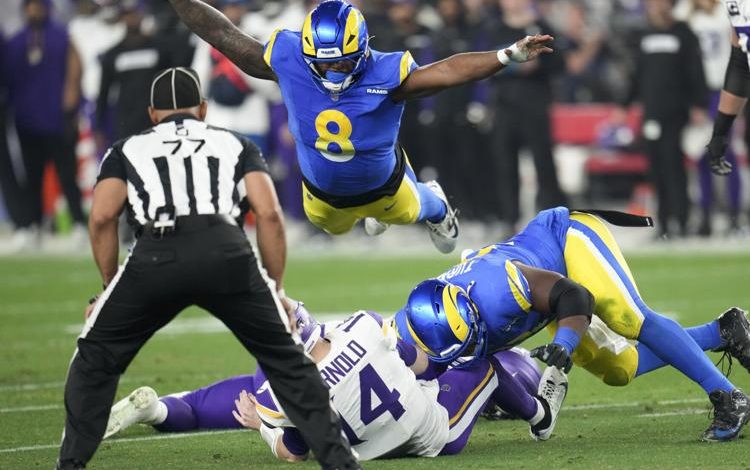Due to fires in the Los Angeles area, Monday’s Vikings-Rams wild-card game was shifted to Arizona.

The unpredictable nature of natural disasters has often altered the course of sporting events, from hurricanes delaying baseball games to tornadoes forcing football teams to relocate. However, in a rare and unprecedented event, the Vikings-Rams wild-card game, originally set to take place in Los Angeles, was shifted to Arizona due to wildfires raging in the Southern California area. This dramatic change in location, announced only a few days before the game, set the stage for one of the most unusual and intriguing playoff matchups in recent NFL history. While the shift raised numerous logistical questions, the game itself would prove to be just as captivating as it was historic.
In this article, we’ll explore the circumstances surrounding the relocation of the game, the impact of the fires on the local community, how this change affected both teams, and the eventual outcome of the Vikings-Rams wild-card matchup in Arizona. Furthermore, we’ll consider how this incident reflects the broader challenges that professional sports face when confronted with unpredictable events, and the resilience of the league in managing such crises.
The Wildfires in Southern California: A Devastating Situation
Southern California is no stranger to wildfires, with the region frequently experiencing devastating fires during the dry, hot summer and fall months. However, the fires that forced the rescheduling of the Vikings-Rams wild-card game were particularly severe. In early January, high winds and dry conditions ignited several wildfires in the Los Angeles area, creating an urgent situation that threatened not only the environment but also the safety of thousands of residents.
The fires, fueled by the Santa Ana winds and dry vegetation, spread quickly across large swaths of the city and surrounding areas. Entire neighborhoods were evacuated, and many homes and businesses were destroyed or severely damaged. The scale of the destruction led local authorities to declare a state of emergency, urging citizens to stay indoors and avoid unnecessary travel. While the NFL and the Los Angeles Rams organization initially hoped that the game could proceed as scheduled, the severity of the situation made it impossible to proceed with the game in the original location.
Los Angeles, the home of the Rams, was under a significant air quality warning due to smoke from the fires. The situation was dangerous for both fans and players, and the NFL and local officials agreed that moving the game was the best course of action to ensure the safety of all involved. The decision was made to relocate the game to Arizona, which offered a safer and more stable environment for the game to take place.
The Decision to Relocate the Game to Arizona
The decision to relocate the wild-card playoff game was an unusual one, as NFL games are typically played at the home stadiums of the respective teams. The Vikings, as the visiting team, were slated to travel to Los Angeles to face the Rams in their home stadium, SoFi Stadium, which had hosted several high-profile games in recent years, including the Super Bowl earlier in 2023. The move to Arizona, home of the Arizona Cardinals, was a swift and necessary decision.
Arizona offered a number of advantages, including a neutral location and a stadium that was equipped to handle the demands of a high-stakes playoff game. State Farm Stadium in Glendale, Arizona, which had hosted multiple Super Bowls and major events, was ready to accommodate the game on short notice. Moreover, Arizona was geographically closer to Los Angeles than other potential locations, making the logistical process of relocating the game easier for both teams.
The decision, however, did not come without its challenges. The quick relocation meant that both teams had to adjust their travel plans, practice schedules, and accommodations. Both the Vikings and the Rams had to rework their strategies for a neutral-site game, with the location change potentially disrupting their game plans and pre-game preparations.
Additionally, the decision raised concerns about the financial implications for both teams and the league, particularly since a significant amount of revenue generated by the game would be lost due to the absence of fans in the stadium. SoFi Stadium, which had a seating capacity of over 70,000, would have been a major revenue generator for the game. With the game now being played in a stadium without the usual home-field advantage for the Rams, both teams faced an uncertain financial impact.
Still, the NFL showed resilience in handling the crisis, ensuring that the game could take place without further delay. Officials worked quickly with Arizona and local law enforcement to guarantee the safety of the players, coaches, and fans who would eventually attend the relocated game.
The Impact on the Teams: A Neutral Ground and High Stakes
The Vikings and Rams were both poised to make a deep playoff run, and the wild-card matchup was crucial for both teams. The Vikings, led by head coach Kevin O’Connell and quarterback Kirk Cousins, had been one of the most consistent teams in the NFC all season. With star players like Justin Jefferson and Dalvin Cook, the Vikings were looking to make a statement in the postseason and continue their push for a championship.
On the other hand, the Rams, coached by Sean McVay and led by star players like quarterback Matthew Stafford, wide receiver Cooper Kupp, and defensive powerhouse Aaron Donald, were eager to put their championship-caliber team to the test. The Rams had high expectations heading into the postseason, but a few key injuries and inconsistencies had caused them to fall short of their lofty goals in the regular season.
Both teams had been preparing for the game to take place at SoFi Stadium, a venue where the Rams felt comfortable and confident. However, the relocation to Arizona meant that both teams would have to adapt to a neutral site with no clear advantage. This presented a unique challenge, as both teams were used to home-field conditions, and the change could potentially affect game-day dynamics.
For the Vikings, the neutral location meant that they wouldn’t have the raucous support of their home fans. However, it also removed the psychological disadvantage that comes with playing on the road in front of a hostile crowd. In many ways, the shift to Arizona leveled the playing field, with both teams having to adjust to an unfamiliar environment.
The Rams, on the other hand, had hoped to use the atmosphere of SoFi Stadium as a psychological advantage, but with the move to Arizona, they lost that edge. The change required a mental reset for McVay’s squad, as they would now have to face a capable opponent without the familiar comforts of their home stadium.
Despite the challenges, both teams remained focused on the game itself. The Vikings were determined to prove their worth in the postseason, while the Rams saw the relocation as a temporary setback that they could overcome.
The Game Itself: An Exciting Wild-Card Matchup
With the game relocated to Arizona, both teams adjusted their preparations. The Vikings and Rams quickly set up new practice facilities, and both teams took to the field at State Farm Stadium with the stakes higher than ever. As the game kicked off, fans from both teams watched in eager anticipation. Though the stadium wasn’t packed to capacity, the atmosphere remained electric, with both fanbases still finding a way to support their teams in the neutral setting.
The first half of the game was a back-and-forth battle, with both teams showcasing their respective strengths. The Rams’ defense, led by Aaron Donald, was stifling, while the Vikings relied on their explosive offense led by Kirk Cousins and wide receiver Justin Jefferson. The game was tied heading into halftime, with both teams showcasing their best plays and strategies, despite the neutral environment.
In the second half, the intensity of the game ramped up as the stakes became clearer. The Rams’ experience in high-pressure situations began to show, with Stafford and Kupp connecting on several key plays to move the ball down the field. The Vikings, however, weren’t backing down. Dalvin Cook found success on the ground, and Cousins was able to make critical throws to Jefferson, keeping the game close and competitive.
The game ultimately came down to a final drive. With just under two minutes left in the fourth quarter, the Vikings had the ball, trailing by three points. Cousins and his offense executed a methodical and effective drive, moving the ball quickly downfield. However, the Rams’ defense, with Donald applying constant pressure, forced a turnover on downs in the final moments of the game.
When the clock hit zero, the Rams emerged victorious, winning the wild-card matchup 27-24. Despite the disruption of playing in a neutral venue, both teams showcased their talent and heart. The Vikings fought valiantly, but the Rams were able to capitalize on key moments, securing their spot in the divisional round.
Reflection: A Historic Moment for the NFL
While the Rams’ victory would be remembered as a thrilling playoff performance, the circumstances surrounding the game’s relocation were also significant. This was the first time in modern NFL history that a playoff game had been moved due to natural disasters, highlighting the challenges faced by the league in ensuring the safety of players, coaches, and fans. The quick decision-making and seamless relocation process demonstrated the NFL’s commitment to managing such crises efficiently.
For the Vikings, the loss marked the end of their playoff run, but it served as a reminder of the unpredictable nature of both the sport and the world around it. The situation in Los Angeles had forced both teams to adapt quickly, and the final result was a testament to the resilience of everyone involved.
In the end, the Vikings-Rams wild-card game in Arizona would be remembered not only for its thrilling conclusion but for the extraordinary circumstances that led to it. This was a game shaped by adversity, both on and off the field, and it exemplified the spirit of the NFL as a league capable of overcoming any challenge—whether it be natural disasters, changes in venue, or the intensity of the playoff atmosphere.









